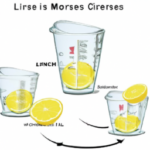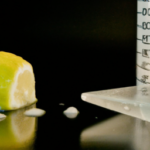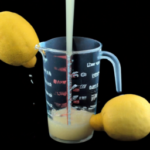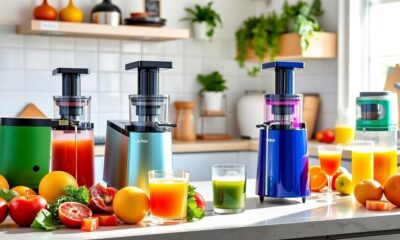Juice Tips and Tricks
How Much Juice Can You Get From One Lemon

Have you ever heard the phrase, ‘When life hands you lemons, make lemonade’?
Well, as a self-proclaimed lemonade enthusiast, I can attest to the fact that the key to a perfect glass of lemonade is the amount of juice you can extract from each lemon. But how much juice can you really get from one lemon?
As someone who has spent countless hours squeezing lemons by hand, I was determined to find out. Through my research, I discovered that the amount of juice you can extract from a lemon depends on a variety of factors, such as the ripeness of the lemon and the method used to extract the juice.
In this article, I’ll share with you the insights I’ve gained on how to get the most juice out of your lemons and the creative ways you can use that juice beyond just lemonade.
Key Takeaways
- The amount of juice extracted from a lemon depends on ripeness, size, and extraction method. Warming up the lemon before squeezing, using a citrus juicer or reamer, and cutting the lemon in half crosswise can help maximize extraction.
- Masticating juicers use a slow, grinding motion for higher yield and nutrient-rich juice, while centrifugal juicers use high-speed spinning. Masticating juicers are more versatile and quieter than centrifugal juicers.
- Lemon juice can impact texture and chemical reactions in cooking, tenderize meat, prevent fruit oxidation, and curdle dairy and interfere with baked goods rise if too much is used. Measuring lemon juice accurately is important in recipes.
- To choose quality lemons, look for plump, heavy fruit with smooth, thin skin, and avoid bruises or soft spots. Different lemon varieties include Meyer and Eureka. Lemon juice has health benefits, aids digestion, boosts immunity, and improves skin health, and can be used in cooking, homemade salad dressings, and unexpected ways.
The Importance of Knowing How Much Juice You Can Get from One Lemon
You need to know how much juice you can squeeze out of a single lemon, so you don’t end up with a sad, dry slice of citrus. The science behind lemon juice extraction is fascinating – it all comes down to the lemon’s structure and the way its juice is stored.
The juice is contained in tiny sacs within the lemon, and it’s released when pressure is applied. The sacs are surrounded by membranes that can be tough to break down, which is why certain techniques are more effective than others.
Knowing how much juice you can get from one lemon is especially important when you’re cooking or baking. Lemon juice can add a bright, citrusy flavor to dishes, but it can also impact the texture and chemical reactions that occur during cooking.
For example, lemon juice can help tenderize meat or prevent certain fruits from oxidizing and turning brown. It can also curdle dairy or interfere with the rise of baked goods if too much is used. Understanding how much juice to use is key to achieving the desired outcome in your recipes.
Now, let’s dive into the factors that affect the amount of juice you can extract from a single lemon. Several variables can influence how much juice from one lemon you’ll be able to extract, including the size and ripeness of the lemon itself. Larger and fully ripe lemons tend to produce more juice due to their higher water content. Additionally, the method you use to juice the lemon—whether by hand or with a juicer—can impact the overall yield.
Factors That Affect the Amount of Juice You Can Extract
Squeeze and twist the lemon in different ways to reveal its hidden potential for extracting every last drop of its tangy essence. But did you know that the amount of juice you can get from a lemon is affected by various factors?
The ripeness of the lemon, its size, and even the temperature can influence the amount of juice you can extract. A ripe lemon will yield more juice than an unripe one, while a larger lemon will produce more juice than a smaller one. Additionally, warming up the lemon before squeezing it can help release more juice.
Other factors that can affect the amount of juice include the method of squeezing, the pressure applied, and the type of juicer used. To get the most juice out of a lemon, use a citrus juicer or reamer, apply gentle pressure, and rotate the lemon as you squeeze.
Remember to preserve any leftover juice by storing it in an airtight container in the refrigerator. In the next section, I’ll discuss how to prepare lemons for optimal juice extraction.
How to Prepare Lemons for Optimal Juice Extraction
Before preparing lemons for optimal juice extraction, it’s important to know that the ripeness, size, and temperature of the lemon can all affect the amount of juice you’ll be able to extract. To ensure maximum juice extraction, follow these steps:
-
Roll the lemon on a hard surface. This will help to break down the membranes inside the fruit, making it easier to extract the juice.
-
Cut the lemon in half crosswise. This will give you more surface area to work with and make it easier to squeeze the juice out.
-
Squeeze the lemon with a lemon squeezer or by hand. If you’re using a lemon squeezer, make sure to position the lemon cut side down and apply even pressure to both handles. If you’re squeezing by hand, use your palm to apply pressure to the lemon while rolling it back and forth on the surface.
-
To preserve the lemon juice for later use, store it in an airtight container in the refrigerator for up to a week.
Lemon squeezing techniques and lemon juice preservation are crucial to getting the most out of your lemons. With these tips, you’ll be able to extract as much juice as possible and keep it fresh for future use.
In the next section, we’ll explore manual methods for extracting lemon juice.
Manual Methods for Extracting Lemon Juice
Let’s explore some simple ways to manually extract fresh lemon juice for all your cooking and baking needs. When it comes to manual lemon squeezing, there are two main options: hand squeezing and using a lemon press. The table below outlines the pros and cons of each technique.
| Technique | Pros | Cons |
|---|---|---|
| Hand squeezing | Affordable, easy to do, good for small amounts of juice | Can be difficult to get all the juice out, can be messy |
| Lemon press | Efficient, easy to use, gets more juice out | Can be expensive, takes up storage space |
When hand squeezing lemons, it’s important to roll the lemon on a hard surface before cutting it in half. This breaks down the pulp and makes it easier to extract all the juice. Place the lemon half over a bowl or cup and use your hand to squeeze the lemon, rotating it as you go to make sure you get all the juice out. This technique works well for small amounts of juice, but may be time-consuming for larger quantities.
If you’re looking for a faster and more efficient way to extract lemon juice manually, a lemon press may be the way to go. Simply cut the lemon in half and place it cut-side down in the press. Squeeze the handles together and the juice will be extracted from the lemon. This technique is great for larger quantities of juice and ensures that all the juice is extracted from the lemon. However, lemon presses can be expensive and take up storage space.
Next, let’s take a look at electric juicers and how they can make the process even easier.
Electric Juicers
I’ve found that electric juicers are an efficient and convenient way to extract lemon juice.
There are two main types of electric juicers: centrifugal juicers and masticating juicers.
Centrifugal juicers use high-speed spinning to extract the juice, while masticating juicers use a slower, grinding motion.
Centrifugal Juicers
Centrifugal juicers are my go-to choice when it comes to juicing lemons. These juicers are designed to extract juice from fruits and vegetables at high speeds, using a spinning blade to shred the produce and a mesh filter to separate the juice from the pulp. The result is a quick, efficient, and reliable way to get a significant amount of juice from one lemon in just seconds.
When it comes to juicing techniques, using a centrifugal juicer is pretty straightforward. All you need to do is cut the lemon in half, place it on the juicer’s feed chute, and turn on the machine. The centrifugal force created by the spinning blade will extract the juice and send it through the mesh filter, while the pulp and other solids are collected in a separate container.
As for juicer maintenance, it’s essential to clean the machine thoroughly after each use, as the pulp and other debris can accumulate inside the machine and affect its performance over time.
Moving on to masticating juicers, these machines work differently from centrifugal juicers. Instead of using a spinning blade, masticating juicers rely on a slow, grinding motion to extract juice from fruits and vegetables. This process is more time-consuming but can result in a higher yield of juice and a more nutrient-rich end product.
Masticating Juicers
Masticating juicers may take longer to extract juice, but the nutrient-rich end product is worth the wait and will leave you feeling healthier and more energized. Here’s why:
-
Juice yield: Masticating juicers are known for their higher juice yield compared to centrifugal juicers. They work by chewing and crushing fruits and vegetables to extract juice, resulting in a higher volume of juice. This means you can get more juice from one lemon using a masticating juicer compared to a centrifugal juicer.
-
Nutritional benefits: Masticating juicers operate at a slower speed, which means less heat and oxidation that can damage the nutrients in the juice. This results in a more nutrient-dense juice that retains more of the vitamins, minerals, and enzymes present in the fruits and vegetables. So, not only will you get more juice from one lemon using a masticating juicer, but the juice will also be more nutritious.
-
Versatility: Masticating juicers are also more versatile than centrifugal juicers. They can handle a wider range of fruits and vegetables, including leafy greens and wheatgrass, which are often difficult to juice with a centrifugal juicer.
-
Quieter operation: Masticating juicers operate at a lower decibel level than centrifugal juicers, making them a better choice for those who want to juice early in the morning or late at night without waking up the whole family.
Now that we know the benefits of using a masticating juicer, let’s move on to the next topic: how to measure lemon juice.
How to Measure Lemon Juice
To measure lemon juice, you can simply cut the lemon in half and squeeze it by hand or with a citrus juicer. Measuring accuracy is important, especially when following a recipe that requires a specific amount of lemon juice. It’s recommended to use a liquid measuring cup to ensure the correct amount of juice is added.
There are different techniques for squeezing a lemon, including rolling it on a hard surface before cutting it in half or microwaving it for a few seconds to make it easier to juice. However, regardless of the technique used, one lemon can yield up to 1/4 cup of juice. Knowing how to measure and extract lemon juice accurately is crucial in achieving the desired flavor in dishes.
When it comes to juicing lemons, the amount of juice you can expect to get from one lemon can vary depending on its size and ripeness. In the next section, we’ll explore some factors that can affect the amount of juice you can get from a lemon.
How Much Juice You Can Expect to Get from One Lemon
Did you know that the size and ripeness of a lemon can affect the amount of tangy goodness you can extract from it? The truth is, not all lemons are created equal. Some may have more juice than others, and the ripeness of the fruit can also play a role in how much juice you can get. To give you an idea of how much juice you can expect to get from one lemon, take a look at the table below:
| Size of Lemon | Amount of Juice |
|---|---|
| Small | 1-2 tablespoons |
| Medium | 2-3 tablespoons |
| Large | 3-4 tablespoons |
These measurements are estimates, but they should give you a rough idea of how much juice you can expect to get. Keep in mind that recipes using lemon juice may call for different amounts, so adjust accordingly. It’s also worth noting that lemon juice has numerous health benefits, such as aiding digestion, boosting immunity, and improving skin health. So, don’t be afraid to use it generously in your cooking and drinks.
Now that you have an idea of how much juice you can get from one lemon, let’s talk about some tips for getting the most juice out of your lemons.
Tips for Getting the Most Juice Out of Your Lemons
When it comes to getting the most juice out of your lemons, there are a few tips that I swear by. Firstly, choose the right lemons – ones that are plump and heavy for their size. Secondly, warm your lemons before juicing to help release more juice. Lastly, roll your lemons on a hard surface before juicing to break down the pulp and yield more juice.
These simple tricks have helped me maximize the juice output from my lemons every time.
Choosing the Right Lemons
Pick plump, perfect lemons for maximum juice potential, advises you, the juice-seeking juicer. When it comes to choosing quality lemons, there are a few things to keep in mind.
First, look for lemons that are heavy for their size. This indicates that they are juicy and full of liquid. Additionally, choose lemons that are bright yellow and have a smooth, thin skin. Avoid lemons with bruises or soft spots as they may contain less juice or be past their prime.
There are a few different lemon varieties to consider when picking out your fruit. Meyer lemons are a popular choice as they are sweeter and less acidic than other varieties, making them ideal for cocktails and desserts. Eureka lemons are a more traditional option with a tart, tangy flavor that works well in savory dishes.
Ultimately, the type of lemon you choose will depend on your personal preference and the recipe you are using. With the right lemons in hand, you’ll be well on your way to juicing success.
And speaking of success, warming your lemons before juicing can help you extract even more juice.
Warming Lemons Before Juicing
Warming your lemons before juicing can enhance the flavor and yield of your citrus creations. Citrus fruits, including lemons, are best juiced at room temperature. This is because the warmth helps to activate enzymes in the fruit, leading to a more efficient and effective extraction of juice.
Additionally, room temperature fruits are easier to juice, as they’re softer and juicier than those that are chilled. To warm your lemons, simply leave them at room temperature for a few hours before juicing. If you need to juice them sooner, you can also warm them in the microwave for a few seconds. However, be careful not to overheat them, as this can cause them to dry out and become less juicy.
For the best results, juice your lemons in the morning, when they’re at their juiciest and most flavorful. Rolling lemons before juicing can also help to extract more juice from them. By applying pressure to the fruit, you can break down the membranes inside and release more of the juice. To do this, simply place the lemon on a hard surface and roll it back and forth with the palm of your hand.
Once you’ve warmed and rolled your lemons, you’re ready to start juicing!
Rolling Lemons Before Juicing
Rolling lemons before juicing can definitely help to extract more of their flavorful juices. This rolling technique benefits the juicing process by breaking down the lemon’s cellular structure, making it easier to extract all of the juice. It also helps to release the essential oils from the lemon peel, adding even more flavor to your juice.
To put this to the test, I compared the amount of juice I was able to extract from a lemon using a lemon squeezer before and after rolling it. The difference was significant, with the rolled lemon producing almost twice as much juice as the unrolled one. This simple technique can make a big difference in the amount of juice you’re able to get from each lemon, making it a worthwhile step to include in your juicing process.
Moving on to the next section about creative uses for lemon juice, one of my favorite ways to use all of the extra juice is in homemade salad dressings. By combining lemon juice with olive oil, Dijon mustard, and a touch of honey, you can create a delicious and tangy dressing that’s perfect for drizzling over fresh greens.
Creative Uses for Lemon Juice
Did you know that lemon juice can be used for more than just cooking and baking? Lemon juice can actually be used as a natural highlighter for your hair! Here are some other creative uses for lemon juice:
-
Brighten up your nails by soaking them in lemon juice for a few minutes.
-
Use leftover lemon peels to make a natural air freshener by simmering them in a pot of water with some cinnamon and cloves.
-
Incorporate lemon juice into your cocktails for a refreshing twist on classic drinks like the margarita or gin and tonic.
Lemon juice is a versatile ingredient that can be used in many unexpected ways. But it’s important to note that lemon juice can also be acidic and potentially harmful to your skin or hair if used improperly. Always do a patch test before trying out a new use for lemon juice, and be sure to dilute it with water if necessary.
Frequently Asked Questions
How long do lemons typically last before they start to lose their juice?
Lemon juice shelf life can vary depending on factors such as storage conditions and oxidation. Typically, lemons will start to lose their juice after a few days, and oxidation can further reduce their shelf life.
Is it better to use a specific type of lemon for juicing, such as Meyer lemons?
I know it may seem like using a specific type of lemon for juicing, such as Meyer or Eureka, is important, but in reality, any variety will work. However, to maximize yield, choose lemons that are heavy for their size and have smooth, thin skin. Meyer lemons are slightly sweeter and may have a higher yield, but it ultimately comes down to personal preference.
Can you freeze lemon juice for later use?
Yes, lemon juice can be frozen for later use using proper Freezing Techniques and Storage Methods. It can be stored for up to 4-6 months in the freezer, maintaining its quality and flavor.
How do you know if a lemon is ripe and ready for juicing?
Wow, trying to find a ripe lemon is like searching for a needle in a haystack! To tell if a lemon is ready for juicing, gently squeeze it. A ripe lemon will give slightly when pressed. For the best results when squeezing, roll the lemon on a hard surface before cutting.
Are there any health benefits associated with drinking lemon juice regularly?
Drinking lemon juice regularly has numerous health benefits, including aiding digestion, promoting hydration, and boosting immunity. Lemon juice detoxes the body by flushing out toxins and improving liver function.
Conclusion
In conclusion, you can get varying amounts of juice from one lemon depending on different factors. It’s crucial to know how to extract the maximum amount of juice to make the most out of your lemons. Like a skilled surgeon, you must carefully prepare the lemons to ensure a successful extraction.
Whether you prefer manual or electric methods, it’s important to measure the juice accurately to prevent waste and achieve consistent results. Lemons are like life; you must know how to make the most out of them. With the right knowledge and techniques, you can get the most juice out of your lemons and create delicious dishes and beverages.
Remember to keep your lemons fresh and avoid over-squeezing them to prevent bitterness. With these tips, you can become a lemon juice extraction master and impress your friends and family with your culinary skills.
Cindy thoroughly researches juicing trends, techniques, and recipes to provide readers with practical advice and inspiration. Her writing style is accessible, engaging, and designed to make complex concepts easy to understand. Cindy’s dedication to promoting the advantages of juicing shines through her work, empowering readers to make positive changes in their lives through the simple act of juicing.
Juice Tips and Tricks
How Much Juice In Two Limes
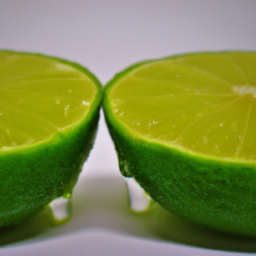
I’ve always loved limes. Whether I’m adding them to my guacamole for a zesty twist or squeezing their juice over fish tacos, they are a key ingredient in my cooking. But have you ever considered how much juice only two limes can produce?
As it turns out, there are several factors that can affect the amount of juice you can extract from a lime, so the answer isn’t as straightforward as you might think. In this article, I’ll provide an overview of lime juice and the factors that can influence how much juice you can get from a lime. I’ll also answer the burning question on many people’s minds: just how much juice is in two limes?
Additionally, I’ll provide some tips for getting the most juice out of your limes, discuss other uses for lime juice, and provide some nutritional information about this citrus fruit. So let’s dive in and explore the world of limes!
Key Takeaways
- Two limes will give you roughly 1/4 to 1/3 cup of juice.
- Using a citrus press can extract more juice than squeezing the lime by hand.
- Rolling the limes on a hard surface can break down the pulp and make the juice easier to extract.
- Microwaving the limes for about 10-15 seconds can also help extract more juice.
Overview of Lime Juice
You can get about two tablespoons of lime juice from two average-sized limes. Lime juice is a great addition to many recipes, including marinades, dressings, and cocktails. It has a tangy and refreshing flavor that can enhance the taste of any dish.
Not only does lime juice add flavor, but it also has many health benefits. It’s rich in vitamin C, which helps boost the immune system and fight off illnesses. Lime juice also contains antioxidants that can help reduce inflammation and lower the risk of chronic diseases.
In addition to its health benefits, lime juice is a versatile ingredient that can be used in a variety of recipes. It pairs well with seafood, chicken, and other meats, as well as fruits and vegetables. Some popular lime juice recipes include ceviche, guacamole, and margaritas.
However, the amount of juice you can get from two limes can vary depending on several factors, such as the size and ripeness of the limes.
Factors Affecting Lime Juice Amount
When squeezing fresh limes, the amount of juice extracted can be influenced by several factors. One of these factors is the ripeness of the lime. Ripe limes tend to be juicier than unripe ones. When a lime is ripe, it feels heavy for its size, and the skin gives slightly when you press it. On the other hand, an unripe lime will feel light and hard, and the skin will be tough.
Another factor that affects the amount of juice in a lime is the juicing technique used. For instance, using a citrus press can extract more juice than squeezing the lime by hand. When using a press, the pressure applied is uniform, and all the juice is squeezed out. However, when squeezing by hand, the pressure applied may not be consistent, and some juice may be left in the fruit.
These are some of the factors that can affect the amount of juice in a lime. Now, let’s move on to the next section and find out how much juice is in one lime.
How Much Juice is in One Lime?
Get ready to discover just how much delicious limey goodness you can expect from a single lime! When it comes to lime juice, it’s important to note that the amount of juice you can get from a single lime can vary depending on its size, ripeness, and juiciness. However, on average, you can expect to get about 2 tablespoons (30 mL) of lime juice from one lime. Keep in mind that larger, well-ripened limes may yield more than 2 tablespoons, while smaller or less ripe limes might give a bit less. If you’re ever in doubt about how much juice in one lime you’ll get, gently rolling the lime on the counter before cutting can help release more juice. Regardless of the exact amount, fresh lime juice always packs a tangy punch that enhances the flavor of any dish or drink!
But why bother with lime juice at all? Well, besides adding a zesty flavor to your dishes, lime juice is also packed with health benefits. It’s a great source of vitamin C, which can boost your immune system and improve skin health. Lime juice also contains antioxidants that can help protect against chronic diseases.
Some popular recipes that use lime juice include guacamole, ceviche, and margaritas.
And speaking of recipes, now that we’ve covered how much juice you can get from one lime, let’s move on to the next question: how much juice is in two limes?
How Much Juice is in Two Limes?
Double the citrus delight with a duo of limes, as the amount of tangy liquid you’ll extract can be determined by their size and ripeness. When it comes to juicing limes, two of them will give you roughly 1/4 to 1/3 cup of juice. However, this can vary depending on the size of the limes and how ripe they are.
It’s important to note that using freshly squeezed lime juice in cocktails can elevate the taste and bring out the flavors of other ingredients. Consuming lime juice regularly can also have numerous health benefits. It’s rich in vitamin C, which is essential for a healthy immune system. Lime juice can also aid in digestion, promote hydration, and potentially lower the risk of certain diseases.
So, go ahead and double up on those limes for both a delicious and nutritious addition to your drinks and meals. Now, let’s move on to some tips for getting the most juice out of limes.
Tips for Getting the Most Juice Out of Limes
To maximize the amount of tangy liquid extracted from your citrus fruit, you should consider using these expert tips for juicing limes. First, start by rolling the limes on a hard surface to break down the pulp and make the juice easier to extract. Then, cut the limes in half and use a citrus juicer or reamer to squeeze out the juice. Be sure to apply firm pressure when squeezing to get the most juice out of each lime.
Another technique for juice extraction is to microwave the limes for about 10-15 seconds to warm them up before juicing. This will help break down the membranes inside the fruit and make it easier to extract the juice. Additionally, if you’re short on time or don’t have a juicer, you can simply use your hands to squeeze the juice out of the lime halves. With these lime squeezing techniques, you’ll be able to get the most juice out of your limes and add a burst of citrus flavor to your favorite recipes.
When it comes to other uses for lime juice, there are plenty of options to explore. From adding a splash to cocktails and marinades to using it as a natural cleaning solution, lime juice is a versatile ingredient that can be used in a variety of ways.
Other Uses for Lime Juice
There are so many ways to incorporate lime juice into your daily routine beyond just adding it to recipes! One of the most popular uses for lime juice is as a natural detoxifier. Lime juice is high in Vitamin C, which helps flush toxins from the body and boost the immune system.
Drinking a glass of warm water with lime juice and honey first thing in the morning is a great way to start your day and cleanse your body. Another benefit of consuming lime juice is its ability to aid in digestion. The acidity in lime juice helps break down food in the stomach, making it easier to digest.
Additionally, lime juice is a natural diuretic, which means it can help flush excess water from the body and reduce bloating. Adding a squeeze of lime to your water or incorporating it into a salad dressing can provide these digestive benefits.
Now, let’s take a look at the nutritional information of lime juice.
Nutritional Information of Lime Juice
Lime juice is a good source of potassium, with one lime providing almost 10% of the recommended daily intake. This can help regulate blood pressure and support heart health, making lime juice a great addition to any diet. But that’s not all – here are some more benefits of lime juice:
- Lime juice is low in calories, making it a great addition to weight loss diets.
- It’s high in vitamin C, which boosts the immune system and promotes healthy skin.
- Lime juice can help reduce inflammation in the body, which can lead to a variety of health issues.
- It can be used in a variety of recipes, from marinades to cocktails to desserts.
- Lime juice can aid in digestion and relieve constipation.
Overall, lime juice is a versatile and nutritious ingredient that can offer numerous health benefits. In the next section, we’ll compare the nutritional value of lime juice to other citrus fruits.
Comparison to Other Citrus Fruits
As we’ve seen in the previous subtopic, lime juice is a great source of nutrients. But how does it compare to other citrus fruits?
Well, when it comes to vitamin C, lime juice is actually lower than some other citrus fruits, such as oranges and grapefruits. However, it still contains a significant amount of this essential nutrient, as well as other vitamins and minerals.
One of the benefits of consuming citrus fruits is their ability to boost the immune system, thanks to their high vitamin C content. But beyond that, citrus fruits also offer a range of flavors that can add variety to your diet.
From the sourness of limes and lemons to the sweetness of oranges and mandarins, there’s something for everyone. And while the difference in taste between various citrus fruits may seem subtle, it can make a big difference in the flavor of your meals and drinks.
When it comes to storing lime juice, there are a few important things to keep in mind.
How to Store Lime Juice
To keep your lime juice fresh and flavorful, you’ll want to store it properly. Lime juice storage is important if you want to preserve the taste and quality of your citrus fruit. Here are some tips on how to store lime juice:
First, make sure to use a clean container. Any bacteria or dirt left in the container can cause your lime juice to spoil quickly. Secondly, store the container in the refrigerator. Lime juice can spoil quickly when left in room temperature, so keeping it cool will help preserve it. Lastly, consider adding a little bit of sugar or salt to the juice. This can help preserve the flavor and prevent it from going bad too quickly.
| Pros | Cons |
|---|---|
| Keeps lime juice fresh and flavorful | Can be time-consuming |
| Prevents bacteria growth | Can alter taste slightly |
| Easy to do | May not work for all recipes |
| Inexpensive | May not work for all storage containers |
| Can extend shelf life |
Overall, proper lime juice storage is essential for preserving the taste and quality of your citrus fruit. By following these simple steps, you can ensure that your lime juice stays fresh and flavorful for longer periods of time.
Frequently Asked Questions
How do I choose the best limes for juicing?
How can I ensure I choose the best limes for juicing? Start by selecting ones with thin, smooth skin and a little give when squeezed. Roll them on a hard surface to release juices before cutting. Use juicing techniques like hand-squeezing or a citrus juicer for optimal results.
Can I use bottled lime juice instead of fresh lime juice?
I personally prefer using fresh lime juice for its flavor and acidity, but using bottled lime juice can be a convenient option. Pros include longer shelf life and consistent flavor, while cons include added preservatives and a less vibrant taste. Some recipes may require fresh lime juice for optimal results.
How long does lime juice last once it’s been squeezed?
Preserving lime juice freshness requires proper storage in an airtight container in the fridge for up to a week. Use leftover juice in recipes like guacamole or salad dressings, beyond just cocktails and marinades.
Can I freeze lime juice for later use?
Yes, lime juice can be frozen for later use. Freezing benefits include preserving freshness and extending shelf life. To defrost, leave in the fridge or use a microwave. Always use within a few days of defrosting.
Can lime juice be used in cocktails or as a marinade for meat?
I’ve found that lime juice is great in cocktails and as a meat marinade. It’s packed with vitamin C and has a tangy flavor that can’t be beat. If you’re out of lime juice, try lemon juice or vinegar as substitutes.
Conclusion
Well, after all that research, I can confidently say that there’s about 1-2 tablespoons of juice in one lime and 2-4 tablespoons of juice in two limes.
That may not seem like a lot, but it’s important to remember that lime juice is very concentrated and a little goes a long way. In fact, just one lime can provide enough juice for a whole recipe.
But here’s an interesting statistic that may surprise you: according to a study by the USDA, the average American only consumes about 1.5 pounds of citrus fruit per year. That’s less than one piece of fruit per week!
Considering the many health benefits of citrus fruits, such as vitamin C and flavonoids, it’s definitely worth incorporating more into our diets. So next time you’re making a recipe that calls for lime juice, don’t be afraid to use a little extra and enjoy the added health benefits.
Cindy thoroughly researches juicing trends, techniques, and recipes to provide readers with practical advice and inspiration. Her writing style is accessible, engaging, and designed to make complex concepts easy to understand. Cindy’s dedication to promoting the advantages of juicing shines through her work, empowering readers to make positive changes in their lives through the simple act of juicing.
Juice Tips and Tricks
How Much Lemon Juice For One Lemon

Lemons are often overlooked in cooking, even though they bring a burst of flavor to many dishes. As a cooking enthusiast, I understand the significance of using just the right amount of lemon juice in a recipe. However, squeezing juice from lemons can be tricky, and estimating how much juice one lemon will yield is not always straightforward.
That’s why I’m here to help you navigate the world of lemon juice and give you the precise measurements you need to create the perfect lemon-infused dish. Believe it or not, getting the right amount of lemon juice can make or break a recipe. Too little, and you’ll miss out on that bright, tangy flavor that makes lemon so special. Too much, and you’ll overpower your dish with sourness.
That’s why it’s critical to measure lemon juice accurately, taking into account factors like the ripeness of your lemon and the method you use to extract the juice. In this article, I’ll give you all the information you need to measure lemon juice like a pro, so you can enjoy all the benefits of this versatile citrus fruit in your cooking.
Key Takeaways
- One lemon typically yields around 2-3 tablespoons of juice, but this can vary depending on the size and ripeness of the lemon.
- Accurate measuring of lemon juice is crucial for achieving the desired taste and acidity in dishes.
- Bottled lemon juice can be used as a substitute for fresh lemon juice, but it’s important to check the label to ensure it’s 100% lemon juice.
- Leftover lemon juice can be preserved by freezing in an ice cube tray or storing in an airtight container in the fridge, and can be used in a variety of dishes and recipes.
The Importance of Measuring Lemon Juice Accurately
You don’t want to mess up your recipe by eyeballing it – that’s why it’s crucial to measure lemon juice accurately! The importance of measuring lemon juice accurately cannot be overstated.
Fresh lemons are a great source of vitamin C and other nutrients. Adding lemon juice to water can also provide additional benefits, such as aiding in digestion and promoting hydration. However, adding too much or too little lemon juice can greatly affect the taste and texture of your dish or drink.
To ensure that you are adding the correct amount of lemon juice, it is important to measure it accurately. This can be done by using a measuring cup or spoon. If a recipe calls for the juice of one lemon, it is best to use one fresh lemon. However, factors such as the size and ripeness of the lemon can affect the amount of juice it yields.
Now let’s discuss some factors that can affect the yield of lemon juice.
Factors That Affect Lemon Juice Yield
When squeezing a fresh lemon, the amount of liquid extracted can be influenced by various factors. These include the ripeness of the lemon, the temperature of the lemon, the juicing method used, and the pressure applied when squeezing.
For instance, a ripe lemon will yield more juice than an unripe one. Similarly, a warm lemon will produce more juice than a cold one, while using a juicer will result in a higher juice extraction compared to squeezing by hand. Lastly, applying too much pressure when squeezing can produce a bitter taste from the lemon peel.
Another important factor that affects lemon juice yield is the freshness of the lemon. This is because the longer a lemon sits, the drier it becomes, and the less juice it will yield. As a result, it’s best to use fresh lemons when making lemon juice to ensure maximum juice extraction.
Additionally, it’s important to note that the amount of juice that can be extracted from one lemon may vary depending on the factors mentioned above. Therefore, it’s crucial to measure the juice accurately when using it in recipes.
Measuring Lemon Juice for Recipes
Precise portioning of tangy citrus is pivotal in preparing palatable recipes. When it comes to lemon juice, measuring accuracy is important to ensure that the taste and acidity level are just right.
One lemon typically yields around 2-3 tablespoons of juice, but this can vary depending on the size and ripeness of the fruit. To measure the juice, I usually cut the lemon in half and use a citrus reamer or juicer to extract the juice. I then pour the juice through a fine mesh strainer to remove any pulp or seeds, and measure out the desired amount for my recipe. If I’m ever unsure about how much juice in one lemon, I check its size and firmness, as softer, larger lemons tend to yield more. Additionally, rolling the lemon on the counter before cutting can help release more juice. With this method, I can ensure I have the right amount of fresh lemon juice for any recipe.
However, if you don’t have a fresh lemon on hand, there are some lemon juice substitutions that you can use. Bottled lemon juice can be used as a substitute, but be sure to check the label to ensure it is 100% lemon juice and not a blend with other citrus juices.
Another option is to use vinegar or another acidic ingredient such as lime juice or white wine vinegar, but this will alter the flavor of the recipe. Overall, measuring lemon juice accurately is key to achieving the desired taste in your dishes.
When it comes to extracting more juice from lemons, there are some tips and tricks that can be helpful. One method is to roll the lemon on a hard surface before cutting it in half, which can help break down the membranes and release more juice. Another technique is to microwave the lemon for 10-15 seconds before juicing, which can also help release more juice.
Additionally, using a juicer or citrus reamer can be more effective than squeezing the lemon by hand. With these tips in mind, you’ll be able to maximize the amount of juice you get from each lemon.
Tips for Extracting More Juice
When I need to extract more juice from a lemon, I’ve found that a few simple techniques can make a big difference.
First, I like to roll the lemon on a hard surface before cutting it open. This helps to break down the fibers inside and make the juice flow more easily.
Second, I sometimes warm the lemon in the microwave for a few seconds to further soften it up.
Finally, I use a fork to press and twist the lemon halves as I squeeze them, which helps to release even more juice.
Rolling the Lemon
First, you’ll want to roll the lemon on a hard surface to help release the juices before squeezing it. This rolling technique is essential, especially when using lemons that have been sitting for a while. Rolling the lemon helps break down the pulp and fibers inside, allowing the juice to flow more freely and easily.
Here are some tips to help you roll your lemon like a pro:
- Start by applying some pressure on the lemon with the palm of your hand.
- Roll the lemon back and forth with gentle force.
- Apply more pressure to the lemon while rolling it to ensure that all parts of the lemon are being worked on.
- If the lemon is giving you a hard time, try microwaving it for a few seconds to soften it up before rolling.
- Be careful not to roll too hard, as this could cause the lemon to burst open and lose some of its juice.
After rolling the lemon, the next step is to warm it up. This is especially helpful when dealing with cold lemons that have been stored in the refrigerator. Warming the lemon before juicing helps to break down the cell walls in the fruit, making it easier to extract the juice.
Warming the Lemon
After rolling the lemon, it’s helpful to warm it up to make it easier to extract the delicious citrusy goodness. Warming the lemon helps to release the juice easier and faster.
To do this, simply place the lemon in a bowl of warm water for a few minutes before cutting it open. Alternatively, you can microwave the lemon for about 10-15 seconds on high power. Be sure to prick the lemon with a fork a few times before microwaving to prevent it from exploding.
Properly warming a lemon can enhance the flavor of your dishes. Warm lemon juice is more flavorful and aromatic than cold juice, making it perfect for cooking. The heat from the warm lemon juice also helps to bring out the flavors of other ingredients in your recipe.
So, the next time you’re using lemon juice in your recipe, try warming it up first to take your dish to the next level.
Moving on to the next step, using a fork to extract more juice from the lemon is an effective way to get the most juice out of your citrus fruit.
Using a Fork to Extract More Juice
Now that we’ve warmed up our lemon, let’s move on to extracting as much juice as possible. One method that I’ve found to be effective is using a fork to help get the most out of the lemon. Simply cut the lemon in half and hold it over a bowl, then use a fork to pierce and twist the flesh while squeezing the lemon. This can help to release more juice and make it easier to extract every last drop.
Using a fork to extract lemon juice has its benefits and drawbacks. On the one hand, it can be a quick and easy method that doesn’t require any special equipment. On the other hand, it can be messy and difficult to control the amount of juice being extracted. If you’re looking for alternative methods, you could try using a citrus reamer or a juicer.
Whatever method you choose, the goal is to get as much juice as possible to make the most out of your lemon. When it comes to using leftover lemon juice, there are plenty of options to consider. From adding it to salad dressings and marinades to using it as a natural cleaning solution, lemon juice is a versatile ingredient that shouldn’t go to waste.
But before we get into that, let’s first explore another method for extracting lemon juice: hand squeezing.
Using Leftover Lemon Juice
Got some leftover lemon juice? Don’t let it go to waste! Squeeze it into your next salad dressing or marinade for a burst of citrusy flavor.
There are several ways to preserve leftover lemon juice. You can freeze it in an ice cube tray or store it in an airtight container in the fridge. Adding a pinch of salt to the juice can also help extend its shelf life.
But there are also some creative uses for leftover lemon juice. For example, you can add it to your morning smoothie for a refreshing twist. Or mix it with honey and warm water for a soothing and healthy drink. You can even use it as a natural cleaner for your home, as the acidity in lemon juice helps to break down grime and stains.
When it comes to cooking and baking, fresh lemon juice is always best. In the next section, we’ll talk about how to store fresh lemon juice to ensure it stays fresh and flavorful.
How to Store Fresh Lemon Juice
To keep your freshly squeezed lemon juice flavorful and zesty, simply store it in an airtight container in the fridge, making sure to remove any seeds or pulp before pouring it in. Here are some tips on how to preserve lemon juice:
-
Use glass containers: Plastic containers may absorb the scent and flavor of the lemon juice, which can ruin the taste of your dishes.
-
Use airtight containers: This will prevent air and moisture from getting in and causing the lemon juice to spoil quickly.
-
Label and date the container: This will help you keep track of how long the lemon juice has been stored in the fridge.
-
Freeze the lemon juice: If you have excess lemon juice, you can freeze it in ice cube trays. This is a great way to ensure that you always have fresh lemon juice on hand.
If you don’t have fresh lemon juice, there are several substitutes that you can use instead. These include lime juice, apple cider vinegar, white wine vinegar, and citric acid. These substitutes can be used in equal amounts to replace lemon juice in recipes.
Moving on to alternative sources of citrus flavor, there are several other fruits that can be used to add a tangy kick to your dishes.
Alternative Sources of Citrus Flavor
For a more diverse range of flavors, you may want to try incorporating other citrus fruits into your dishes, such as oranges, grapefruits, or even kumquats. Each of these fruits has a unique flavor profile that can add depth and complexity to your recipes. Oranges, for example, have a sweeter taste than lemons and can be used to balance out spicier dishes. Grapefruits have a tart and tangy flavor and can be used to add a refreshing kick to salads or marinades. Kumquats, on the other hand, have a slightly bitter taste and can be used to add a unique twist to desserts or cocktails.
Another way to add citrus flavor to your dishes is by using the peel of lemons or other citrus fruits. The peel contains essential oils that give off a strong aroma and flavor. You can use lemon zest to add a bright and zesty flavor to baked goods or savory dishes like roasted vegetables. Grapefruit peel can be candied and used to add a sweet and tangy flavor to desserts. These creative uses of lemon peel and other citrus peels can elevate your dishes and add a burst of flavor.
To continue exploring the versatility of lemon juice in cooking, let’s take a look at some recipes that use this versatile ingredient in unique ways.
Recipes That Use Lemon Juice
I personally love using lemon juice in my cooking. It’s especially great in salad dressings, marinades, and baked goods. The acidity and tartness of lemon juice adds a bright and refreshing flavor to these dishes.
In salad dressings, I often mix lemon juice with olive oil, honey, and Dijon mustard. This creates a delicious and tangy dressing that pairs well with any type of salad.
When it comes to marinades, I use lemon juice to tenderize and flavor meats, fish, and vegetables. It’s a versatile ingredient that works well with a variety of proteins and veggies.
And in baked goods, lemon juice is a key ingredient in many recipes. From lemon bars to lemon poppy seed muffins and lemon cakes, the zesty flavor of lemon juice adds a delicious twist to traditional desserts.
Salad Dressings
Salad dressings are a versatile way to add flavor to any dish, and knowing how much lemon juice to squeeze from one lemon can make all the difference in creating the perfect dressing. For creative combinations, I recommend experimenting with different ratios of lemon juice to oil and other ingredients such as vinegar, honey, or mustard to achieve the desired taste and consistency.
Oil-based dressings typically require less lemon juice than vinaigrettes, so start with a small amount and add more as needed. When making salad dressings, it’s important to keep in mind that the acidity of lemon juice can vary depending on the ripeness and size of the fruit. A general rule of thumb is to use the juice of half a lemon for every 1/4 cup of oil in an oil-based dressing, or one to two tablespoons of lemon juice for every 1/2 cup of oil in a vinaigrette.
Once you’ve found the perfect balance of flavors, store your dressing in an airtight container in the fridge for up to a week.
Moving on to marinades, let’s explore how lemon juice can be used to tenderize and flavor meats and vegetables.
Marinades
Marinades are a great way to infuse flavor into your meals, and did you know that adding acid like lemon can also help to tenderize meat by breaking down proteins? When making a marinade, it’s important to balance the flavors and acidity. A general rule of thumb is to use one part acid (such as lemon juice) to three parts oil. But how much lemon juice do you need for one lemon?
The amount of juice in a lemon can vary, but on average one lemon contains about 2-3 tablespoons of juice. This can be useful to know when making a marinade, but lemon juice has uses beyond marinades. It’s a great addition to salad dressings, sauces, and even cocktails. Plus, it has health benefits such as being high in vitamin C and aiding in digestion. Now, let’s move on to the next section about baked goods.
Baked Goods
You’re in for a treat with our next subtopic: baked goods! Lemon juice can add a refreshing tang to your cakes, cookies, and bread. But how much lemon juice should you use for one lemon? Here are some tips to help you get the right amount of lemon juice for your baked goods:
-
Squeeze one medium-sized lemon to yield approximately 2-3 tablespoons of lemon juice.
-
If you don’t have fresh lemons, you can substitute 1 tablespoon of lemon juice with ½ teaspoon of lemon extract.
-
To enhance the lemon flavor, add 1 tablespoon of lemon zest for every 2 tablespoons of lemon juice.
-
Be mindful of the acidity level in your recipe. Too much lemon juice can cause your baked goods to become dry and tough.
When baking with lemon juice, it’s essential to balance the acidity with other ingredients. Now let’s move on to the next section about common mistakes when using lemon juice.
Common Mistakes When Using Lemon Juice
If you’re not careful when using lemon juice, you can easily make some common mistakes that can affect the overall taste of your dish.
One of the most common misconceptions is that the amount of juice from one lemon is always the same. However, the juice yield can vary depending on the size and ripeness of the lemon. As a general rule, a medium-sized lemon can provide about 3 to 4 tablespoons of juice, but it’s always a good idea to have an extra lemon on hand in case you need more.
Another common mistake when using lemon juice is not storing it properly. Lemons can quickly lose their juiciness and flavor if left out at room temperature, so it’s best to store them in the refrigerator.
Additionally, once you have cut into a lemon, it’s important to wrap the remaining half tightly in plastic wrap to prevent it from drying out.
By avoiding these common mistakes and properly using and storing lemon juice, you can ensure that your dishes are balanced and flavorful.
Frequently Asked Questions
What are some other fruits that can be used in place of lemon juice?
Possible substitutions for lemon juice include lime, grapefruit, and orange. Each citrus fruit has its own unique flavor profile and health benefits, such as high levels of vitamin C. Experimenting with different fruits can add variety and nutrition to your recipes.
Can bottled lemon juice be used instead of fresh lemon juice?
OMG, bottled lemon juice is a no-go! Fresh lemon juice has a unique flavor profile and a range of health benefits. Bottled juice contains preservatives that may negatively impact the taste and nutritional value.
How long does fresh lemon juice last in the refrigerator?
I’ve found that fresh lemon juice can be preserved in the refrigerator for up to 2 weeks if stored in an airtight container. Proper storage and timely consumption can extend its shelf life.
What are some common recipes that call for lemon juice?
Lemon juice adds a zesty kick to many recipes, from salad dressings to marinades. It’s a versatile ingredient, but if you’re out of fresh lemons, try substitutes like vinegar or bottled lemon juice.
How does the acidity of lemon juice affect the taste of a recipe?
The acidity impact of lemon juice enhances the flavor of a recipe by balancing the sweetness and adding a tangy taste. It also helps in preserving and tenderizing food. Its pH level of 2-3 makes it a natural food preservative.
Conclusion
In conclusion, measuring lemon juice accurately is crucial for achieving the desired taste and consistency in recipes. Factors such as the size, ripeness, and temperature of the lemon can affect its juice yield, so it’s important to measure it carefully. Using a juicer or rolling the lemon on a hard surface can help extract more juice, while storing leftover juice properly can prevent spoilage.
While lemon juice is a popular source of citrus flavor in cooking and baking, other options like lime, grapefruit, and orange juice can also provide a similar tangy taste. Whether you’re making lemonade, salad dressing, or marinades, using the right amount of lemon juice can make all the difference in the final result.
Remember, when life gives you lemons, make sure to measure the juice accurately for a recipe that’s sure to be a hit.
Susannah expertise lies in researching and compiling evidence-based content on juicing, nutrition, and overall health. She is committed to ensuring that The Juicery World offers accurate, up-to-date, and trustworthy information to empower readers to take control of their health. Susannah’s goal is to inspire individuals to embrace juicing as a way to nourish their bodies and live their best lives.
Juice Tips and Tricks
How Much Juice In One Grapefruit
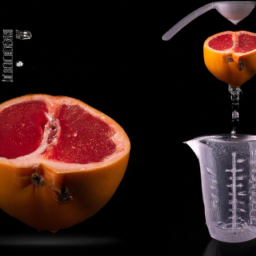
When it comes to enjoying grapefruits, the quantity of juice that can be extracted from this tangy fruit can vary significantly. As a fan of grapefruit juice, I find myself curious about how much juice one grapefruit can yield.
Through research and experimentation, I’ve gathered information on the different grapefruit varieties, factors that affect juice content, and juicing techniques to answer the question of just how much juice is in one grapefruit.
Understanding the amount of juice in one grapefruit is not only useful for those who enjoy fresh squeezed juice, but it can also be helpful for recipes that call for grapefruit juice.
In this article, I’ll explore the different grapefruit varieties and their juice content, the factors that can affect how much juice is in a grapefruit, and the best juicing techniques to maximize juice yield. Additionally, I’ll discuss the benefits of grapefruit juice, how to store it, and how to choose the best grapefruit.
So let’s dive in and discover just how much juice we can expect to get from one grapefruit.
Key Takeaways
- The size, ripeness, and variety of grapefruit affect its juice yield.
- Fully ripe grapefruits are juicier than unripe ones, and Ruby Red and Marsh White are particularly juicy varieties.
- Medium-sized grapefruit yields 1/2 to 3/4 cup of juice and is packed with vitamin C and antioxidants.
- Grapefruit juice has health benefits such as aiding in weight loss and improving heart health, but it can interact with some medications, so consult a healthcare professional.
Overview of Grapefruit Varieties
There’s a wide range of grapefruit varieties, each with their own unique flavor profile. Some grapefruits are sweet and tangy, while others are more acidic and bitter. Depending on the variety, grapefruit can range in color from pale yellow to deep red.
Grapefruit is also known for its high nutritional value, containing large amounts of vitamin C, fiber, and antioxidants. When it comes to juice content, the variety of grapefruit is just one factor that can affect how much juice is in one fruit. Other factors include the age and ripeness of the fruit, as well as how it is stored and prepared.
Understanding these factors can help you get the most juice out of your grapefruit and ensure that you’re getting all of the nutritional benefits it has to offer.
Factors Affecting Juice Content
When it comes to the juice content of grapefruits, there are three main factors that come into play – size, ripeness, and juiciness. As someone who’s spent a lot of time studying citrus fruits, I can tell you that the size of a grapefruit can have a significant impact on how much juice it contains.
Similarly, the ripeness of the fruit and its overall juiciness are also key factors that can impact the amount of juice you can extract from it.
Size of Grapefruit
You can easily tell the size of a grapefruit just by holding it in your hand. Grapefruit size comparison is important when determining the amount of juice that can be extracted from each fruit. Generally, the larger the grapefruit, the more juice it will yield. However, it’s important to note that the nutritional value of different grapefruit sizes may vary.
A larger grapefruit may contain more vitamins and minerals than a smaller one, but it may also have a higher sugar content. When selecting a grapefruit for juicing, it’s important to consider the size that will best suit your needs. If you’re looking to extract a large amount of juice, then a larger grapefruit may be the way to go. However, if you’re looking for a grapefruit with a lower sugar content, then a smaller one may be more suitable.
It’s also important to consider the ripeness of the grapefruit, which will be discussed in the next section.
Ripeness of Grapefruit
As if selecting the perfect grapefruit wasn’t already enough of a challenge, now you get to play a guessing game with the ripeness too. Grapefruit ripeness is crucial in determining its taste and juiciness.
The ideal time to pick a grapefruit is when it feels heavy for its size and has a smooth, firm skin. The color of the skin is also an indicator of ripeness. A ripe grapefruit will have a yellowish-green hue, while an unripe one will be mostly green.
Taste preferences also play a significant role in choosing a ripe grapefruit. Some people prefer a sweeter taste, while others prefer a tangier taste. A ripe grapefruit will have a balance of both, with the sweetness increasing as it ripens further.
To ensure that you get the perfect grapefruit for your taste, it’s best to try a few different ones at different stages of ripeness. This will allow you to determine which one suits your taste buds best.
Moving on to the next section, the juiciness of grapefruit is just as important as its ripeness.
Juiciness of Grapefruit
Get ready to enjoy a refreshing burst of flavor with every bite – nothing beats biting into a juicy grapefruit! But not all grapefruits are created equal when it comes to juiciness.
In fact, the juiciness of grapefruits can vary greatly depending on the variety and ripeness of the fruit. When it comes to juiciness comparison, some grapefruit varieties are known for being particularly juicy, such as the Ruby Red and Marsh White varieties. These grapefruits have thin skins and are packed with juice, making them ideal for squeezing.
As for ripeness, grapefruits that are fully ripe tend to be juicier than those that are not quite ripe yet. Juiciness isn’t the only benefit of grapefruit – it’s also a great source of vitamin C and other nutrients.
Consuming grapefruit regularly has been linked to a variety of health benefits, including weight loss, improved heart health, and reduced risk of certain cancers. So, whether you’re looking for a juicy snack or hoping to reap the health benefits of grapefruit, this citrus fruit is definitely worth incorporating into your diet.
Now, let’s explore some juicing techniques to get the most juice out of your grapefruits.
Juicing Techniques
By using various juicing equipment and techniques, you can extract the most juice from a grapefruit. One of the most popular methods is using a citrus juicer, which can quickly and efficiently extract the juice from the grapefruit. If you don’t have a juicer, you can also use a manual hand juicer or a citrus reamer.
Simply cut the grapefruit in half, place it on the juicer, and press down to extract the juice. Another way to maximize the amount of juice you get from a grapefruit is by experimenting with flavor combinations. Grapefruit has a tart and slightly bitter taste, so adding sweeter fruits like oranges or pineapples can balance the flavors and make the juice more enjoyable.
You can also add herbs like mint or basil for a refreshing twist. By using these techniques, you can create a delicious and nutritious grapefruit juice that will leave you feeling energized and refreshed. So, how much juice can you expect from one grapefruit? Let’s find out in the next section.
How Much Juice in One Grapefruit?
I hope you found the previous subtopic on juicing techniques informative. Now, let’s focus on grapefruit juice. One question that often comes up is, "How much juice is in one grapefruit?"The answer depends on a few factors, such as the size of the grapefruit and the juicing method used. However, on average, a medium-sized grapefruit can yield between 1/2 to 3/4 cup of juice.
Aside from the amount of juice, grapefruit juice nutrition is also a hot topic. It is packed with Vitamin C, which is essential for a healthy immune system. It also contains antioxidants that can help fight against free radicals in the body. Additionally, grapefruit juice has been found to lower cholesterol levels and aid in weight loss. Interestingly, the best time to pick grapefruit is actually in the winter months, as they are in season and have a sweeter taste.
Now that we’ve discussed grapefruit juice nutrition and how much juice is in one grapefruit, let’s move on to the benefits of drinking this delicious juice.
Benefits of Grapefruit Juice
You’ll be pleased to know that sipping on sweet and tangy grapefruit juice can provide a plethora of health benefits for your body and mind.
Grapefruit juice is an excellent source of essential nutrients such as vitamin C, potassium, and fiber. These nutrients are essential for maintaining a healthy immune system, reducing inflammation, and promoting healthy digestion.
Aside from its nutritional value, grapefruit juice may also have potential side effects for certain individuals. For example, grapefruit juice can interact with some medications, including statins, which are used to lower cholesterol levels. It’s essential to consult with a healthcare professional before adding grapefruit juice to your diet to avoid any potential adverse effects.
In the subsequent section about using grapefruit juice, we’ll discuss the different ways you can incorporate this tangy juice into your daily routine.
Using Grapefruit Juice
When it comes to using grapefruit juice, there are a few ways that I like to incorporate it into my diet. First and foremost, I enjoy drinking it straight up for a refreshing and tart kick in the morning.
However, if I want to switch things up a bit, I like to mix it with other juices like orange or pineapple for a sweeter taste.
Lastly, I’ve found that using grapefruit juice in recipes can add a unique flavor profile to dishes like salads, marinades, and cocktails.
Drinking It Straight
If you’re looking to drink grapefruit juice straight, be aware that one grapefruit typically yields about 8-10 ounces of juice. To get the most juice out of your grapefruit, it’s best to use a citrus juicer or a handheld reamer. These methods ensure that you extract as much juice as possible, without wasting any of the fruit.
When drinking grapefruit juice straight, it’s important to consider its nutritional value. Grapefruits are high in vitamin C, potassium, and other important nutrients. However, they can also interfere with certain medications, so it’s important to talk to your doctor before drinking grapefruit juice regularly.
In the next section, we’ll explore how to mix grapefruit juice with other juices to create delicious and nutritious blends. These combinations can enhance the flavor profile and provide a wider array of vitamins and nutrients. For example, mixing grapefruit juice with orange or apple juice can create a refreshing citrus punch. Additionally, if you’re curious about how to blend grape juice with grapefruit, keep in mind that the subtle sweetness of grape juice balances the tanginess of grapefruit, producing a well-rounded and satisfying drink.
Mixing It with Other Juices
Mixing grapefruit juice with other juices can be a refreshing way to enjoy its nutritional benefits, even if you’re not a fan of its tart taste. One popular flavor combination is grapefruit and orange juice, which creates a sweet and tangy flavor. Another option is mixing grapefruit juice with pineapple or cranberry juice for a tropical twist. Adding a splash of lemon or lime juice can also enhance the overall flavor profile.
Aside from its taste, mixing grapefruit juice with other juices can also provide additional health benefits. For example, combining grapefruit juice with carrot juice can increase the amount of vitamin A and antioxidants in your drink. Mixing it with beet juice can provide a boost of iron and potassium.
Overall, experimenting with different flavor combinations can not only make grapefruit juice more enjoyable to drink, but can also provide a variety of nutritional benefits.
Transitioning into the next section, using grapefruit juice in recipes can also be a great way to incorporate its health benefits.
Using It in Recipes
You can easily incorporate grapefruit juice into your meals by using it as a marinade or dressing for your favorite proteins and salads. Combining grapefruit juice with other ingredients such as honey, ginger, and soy sauce can create a flavorful marinade for meats like chicken and pork.
Grapefruit juice also makes for a refreshing dressing when mixed with olive oil, garlic, and herbs for salads. Grapefruit juice cocktails are another way to incorporate this citrus fruit into your diet.
Mix it with vodka and a splash of cranberry juice for a refreshing Greyhound cocktail, or blend it with tequila and lime juice for a tangy Paloma. The possibilities are endless when it comes to creating grapefruit juice cocktails, making it a versatile ingredient for any occasion.
Speaking of occasions, the next step is to learn how to store grapefruit juice to make sure it stays fresh for your next recipe.
Storing Grapefruit Juice
Storing grapefruit juice is easy as it can stay fresh for up to a week when refrigerated. You can also freeze the juice in an airtight container or ice cube tray to extend its shelf life. Make sure to label the container with the date of freezing when using an ice cube tray. The frozen grapefruit juice cubes can be added to drinks or used in recipes later on.
If you prefer a sweeter taste, you can add natural sweeteners like honey, agave, or stevia to your grapefruit juice. However, adding sweeteners can affect the shelf life of the juice, so make sure to consume it within a few days.
Overall, storing grapefruit juice is a simple process that can be done in a variety of ways to maintain its freshness and taste. Now, let’s move on to selecting the best grapefruit for juicing.
Choosing the Best Grapefruit
When it comes to selecting the best grapefruit for juicing, it’s important to look for certain qualities that will ensure a delicious and refreshing drink.
First and foremost, choose a grapefruit that feels heavy for its size, as this indicates it’s full of juice. Look for a smooth, firm and blemish-free skin, with a bright yellow or pink color. These are signs of a ripe and flavorful grapefruit. Also, give it a gentle squeeze to check for firmness. A grapefruit that yields slightly to pressure is likely to have more juice than one that’s too hard or too soft.
Aside from taste preferences, there are also health benefits to consider when selecting a grapefruit. Grapefruits are high in Vitamin C and antioxidants, which can help boost your immune system and protect against cellular damage. They’re also low in calories and high in fiber, making them a great addition to a balanced diet.
When juicing, it’s best to use freshly squeezed grapefruit juice as opposed to store-bought juice, which can contain added sugars and preservatives that can negate any potential health benefits.
As we move on to the subsequent section about common grapefruit myths, it’s important to note that selecting the right grapefruit is just the first step in achieving a delicious and healthy juice.
Common Grapefruit Myths
I want to discuss some common grapefruit myths that I’ve come across. Firstly, there’s a belief that grapefruit interacts with medications and can cause adverse effects.
Secondly, grapefruit is often touted as a weight loss aid, but there isn’t enough evidence to support this claim.
Lastly, there are other misconceptions surrounding grapefruit, such as its ability to cure certain diseases and its impact on cancer.
Let’s explore these myths in detail to separate fact from fiction.
Interaction with Medications
Combining grapefruit with certain medications can cause dangerous interactions, so it’s important to always check with your doctor or pharmacist before consuming it.
Grapefruit drug interactions can occur with a variety of medications, including those used to treat high blood pressure, cholesterol-lowering medications, and antidepressants. When grapefruit is consumed, it can interfere with the enzymes responsible for breaking down these medications in the liver, leading to higher levels of the medication in the bloodstream.
This can potentially lead to serious side effects, including muscle damage, kidney failure, and even death in some cases. It’s important to note that not all medications are affected by grapefruit, and the severity of the interaction can vary depending on the medication and the individual.
However, it’s always better to err on the side of caution and check with a healthcare professional before consuming grapefruit or grapefruit juice if you are taking any medications. With the potential side effects of grapefruit drug interactions in mind, it’s important to move on to the next section and explore the weight loss claims associated with grapefruit.
Weight Loss Claims
To fully understand the weight loss claims associated with grapefruit, it’s important to approach the topic with a critical eye. The effectiveness debate surrounding grapefruit and weight loss centers on the idea that the fruit contains enzymes that can help burn fat. However, scientific evidence supporting this claim is limited and mixed.
While some studies have found a correlation between grapefruit consumption and weight loss, others have found no significant effects. It’s also important to consider that simply adding grapefruit to one’s diet is not a guaranteed way to lose weight. Weight loss is a complex process that is influenced by a variety of factors, including overall diet and exercise habits. While grapefruit may be a healthy addition to a balanced diet, it’s not a magic solution for weight loss.
With this in mind, it’s important to approach any weight loss claims associated with grapefruit with a critical eye and to consult with a healthcare professional before making any significant changes to your diet or exercise routine.
Moving on to other misconceptions about grapefruit, it’s important to address the topic of grapefruit’s impact on medication efficacy.
Other Misconceptions
You know what they say about grapefruit and medication interactions, but the truth is that not all medications are affected by grapefruit and not all grapefruit products have the same effect. While it’s true that grapefruit can interfere with some medications, such as those used to treat high blood pressure, it’s not a concern for all medications.
It’s always important to check with your healthcare provider before consuming grapefruit or grapefruit products if you’re taking any medications.
Apart from its potential interaction with medications, grapefruit has a lot of nutritional value and health benefits. Grapefruit is a rich source of vitamins A and C, potassium, and fiber. It’s also low in calories, making it a great addition to any weight loss diet.
Grapefruit has been shown to improve heart health, lower cholesterol levels, and reduce the risk of certain types of cancer. Additionally, grapefruit can improve digestion and boost the immune system.
So, while grapefruit may not be suitable for everyone, it’s undoubtedly a nutritious and beneficial citrus fruit for those who can consume it safely.
Frequently Asked Questions
Can grapefruit juice be used in cooking or baking?
I’ve found that grapefruit juice can add a unique, tangy flavor to both sweet and savory dishes. Juicy recipes include marinades, dressings, and even desserts. Additionally, exploring the flavor profile of grapefruit juice in cocktails can be a fun and refreshing twist.
What is the best time of day to consume grapefruit juice?
Based on the nutritional value and absorption rate, the best time to consume grapefruit juice is in the morning. However, there are benefits and drawbacks to drinking grapefruit juice, such as potential interactions with medications.
Is it safe to consume grapefruit juice while taking certain medications?
As someone who values their health, it’s crucial to consider medication interactions before consuming grapefruit juice. However, it’s important to note that grapefruit juice has numerous nutritional benefits that should not be overlooked.
How long does it take for grapefruit juice to go bad?
Grapefruit juice can last up to 2 weeks in the refrigerator before going bad. Consuming it daily can provide health benefits such as improved digestion and lower risk of chronic diseases.
Are there any potential side effects of consuming too much grapefruit juice?
I researched the potential risks of consuming too much grapefruit juice. It can interact with medications, causing adverse effects. However, grapefruit juice can aid in weight loss when consumed in moderation.
Conclusion
In conclusion, I was amazed by the amount of juice in one grapefruit when I tried juicing it myself. The yield can vary depending on the variety, size, and age of the fruit. However, by using the right juicing technique and choosing the best grapefruit, you can maximize the juice content and enjoy all the health benefits that come with it.
Grapefruit juice is packed with vitamins, antioxidants, and other nutrients that can boost your immune system, aid digestion, and even help with weight loss. It can be consumed on its own or as a mixer in cocktails and other beverages.
Just make sure to store it properly in airtight containers to preserve its freshness and flavor. Don’t fall for grapefruit myths and give this citrus fruit a chance to brighten up your day and improve your health.
Cindy thoroughly researches juicing trends, techniques, and recipes to provide readers with practical advice and inspiration. Her writing style is accessible, engaging, and designed to make complex concepts easy to understand. Cindy’s dedication to promoting the advantages of juicing shines through her work, empowering readers to make positive changes in their lives through the simple act of juicing.
-

 Popular Juice Brands1 month ago
Popular Juice Brands1 month ago10 Top-Rated Organic Juice Brands to Try
-

 Popular Juice Brands1 month ago
Popular Juice Brands1 month ago9 Best No-Sugar-Added Popular Juice Brands
-

 Juice Tips and Tricks3 days ago
Juice Tips and Tricks3 days agoHow To Make Homemade Pickle Juice
-

 Health Benefits of Juice3 weeks ago
Health Benefits of Juice3 weeks agoHow Much Bottled Lemon Juice Equals 1 Lemon
-

 Vegetable Juices1 month ago
Vegetable Juices1 month ago12 Top Organic Vegetable Juice Brands Reviewed
-

 Juice Tips and Tricks2 weeks ago
Juice Tips and Tricks2 weeks agoHow Long Does Lemon Juice Last After Expiration Date
-

 Vetted3 months ago
Vetted3 months ago15 Best Juices for Diabetics: Refreshing Options That Won’t Spike Your Blood Sugar
-
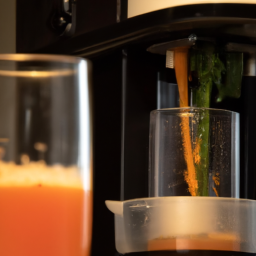
 Juice Tips and Tricks3 weeks ago
Juice Tips and Tricks3 weeks agoHow Long Does Juice Last After Juicing




